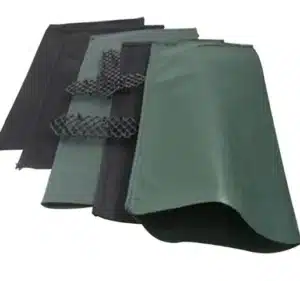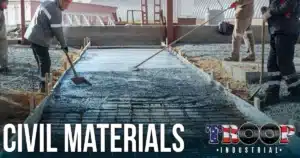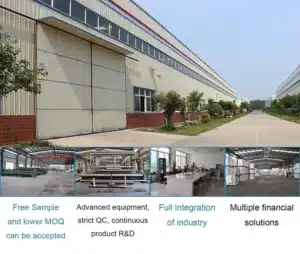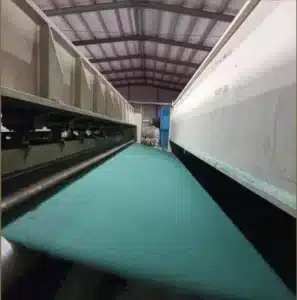Floodwater moves fast. Erosion eats budgets. You may wonder if a simple bag can protect assets without heavy machines.
Geotextile sand bags are fabric containers filled with sand or soil. They build quick flood barriers, armor slopes, form breakwaters, and stabilize worksites. The fabric lets water pass while it holds soil and resists tearing under load.
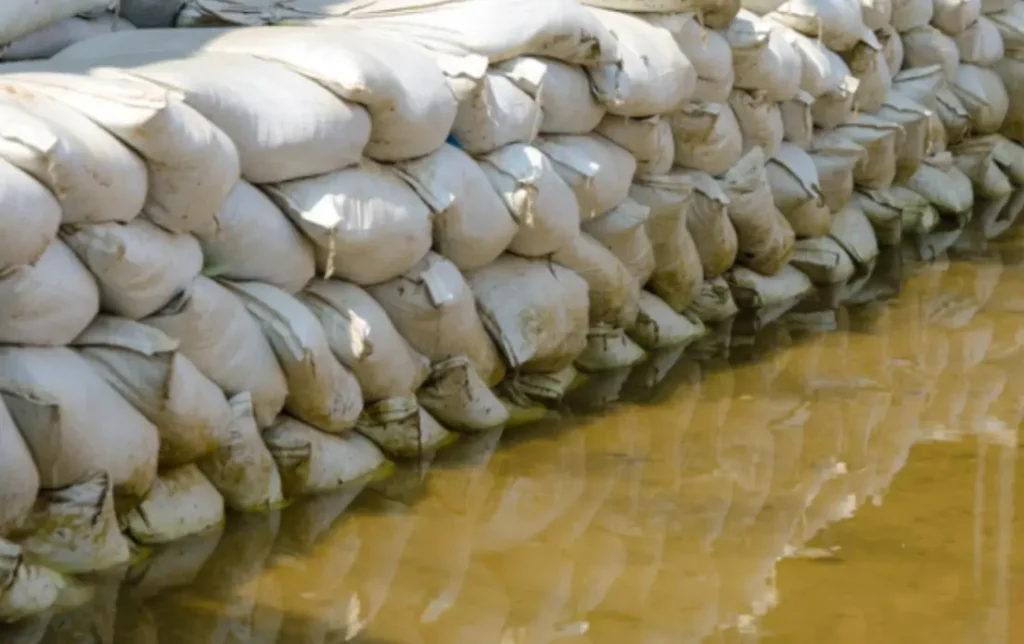
If you buy for projects or resale, you care about material, stitching, size, and delivery. I will walk through definition, makeup, production, uses, pros and cons, field methods, DIY options, selection, and quality tests. Keep this as a checklist for tenders and supplier talks.
What are geotextile sand bags?
You see many names on quotes. Some say geobags, silt bags, or geotextile bags. It is easy to mix them up.
Geotextile sand bags are sewn sacks made from strength-rated geotextiles. They accept granular fill and then act as modular units for hydraulic and geotechnical works. Shape, fabric, and seam strength define their performance.
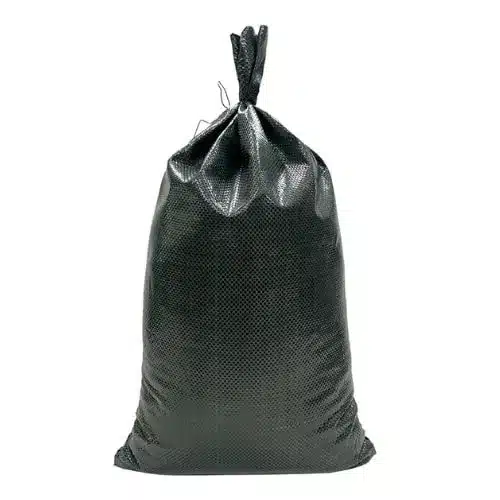
Definition and scope
A geotextile sand bag is a textile container designed to confine sand or soil and resist handling loads, hydraulic forces, and abrasion. The fabric is either woven polypropylene/polyester for high tensile strength and low elongation, or nonwoven needle-punched polypropylene/polyester for better filtration and puncture resistance. Both styles can include UV stabilizers and colorants (often black or beige) for outdoor use.
What they are made of
Typical polymers are PP (polypropylene) and PET (polyester). Woven bags use tapes or multifilament yarns in plain or twill weaves. Nonwoven bags use staple fibers bonded by needle punching, sometimes with thermal calendaring to tune pore size. Additives may include UV stabilizers, antioxidants, and color masterbatch.
How they are produced
Production starts with yarn or staple fiber making, weaving or web forming, then finishing. Fabric rolls are cut to blanks. Industrial machines sew seams with lockstitch or chainstitch using UV-stable threads. Many bags include a drawstring or flap. For large coastal geobags (one to five cubic meters), panels are patterned, double-stitched, and sometimes tape-reinforced at corners and lifting points. QC checks seam strength, dimensions, mass per unit area, and AOS (apparent opening size).
Typical specifications
| Item | Woven PP bag | Nonwoven PP/PET bag | Large coastal geobag |
|---|---|---|---|
| Size (flat) | 45×75 cm | 50×80 cm | Custom, 0.5–5 m³ |
| Fabric mass | 120–200 g/m² | 200–600 g/m² | 400–1000 g/m² |
| Seam type | Lockstitch, single/double | Lockstitch, double | Double seam + tape |
| AOS (O90) | 0.1–0.3 mm | 0.08–0.25 mm | Project-specific |
What are geotextile sand bags used for?
Storms, currents, and traffic move soil. You need quick units that place by hand or small machines.
Geotextile sand bags control floods, armor slopes and riverbanks, build temporary cofferdams, filter silt at inlets, form emergency scour pads, and even make low-cost breakwaters or groynes.
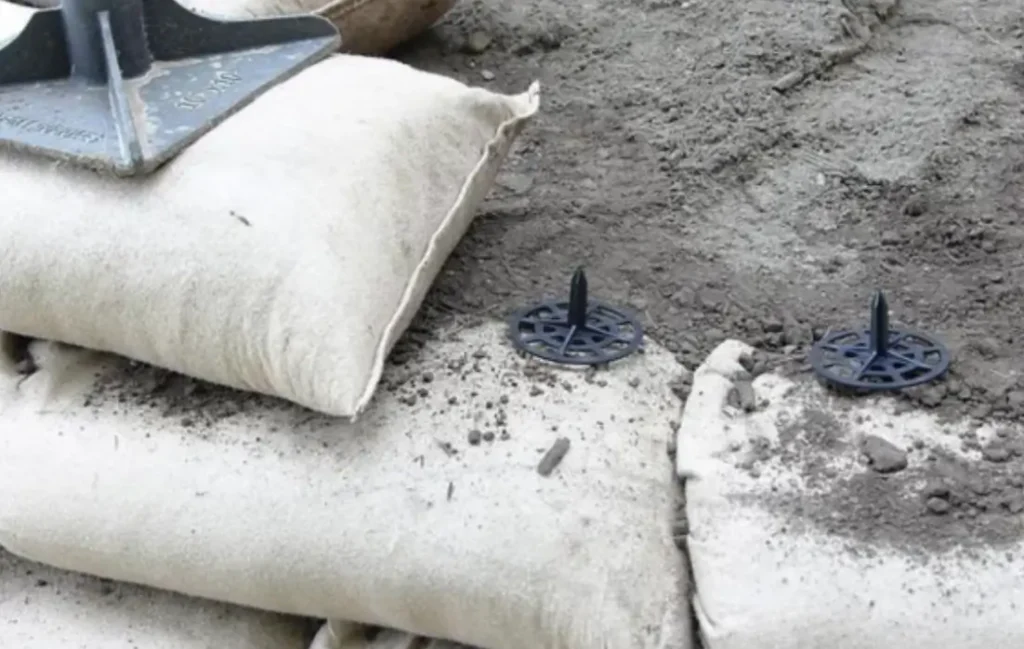
Core application groups
1) Flood control barriers: Stacked bags create serpentine levees that follow streets and doorways. The geotextile allows pressure equalization while keeping soil in place.
2) Erosion and scour protection: Bags stabilize toes of slopes, abutments, and culvert outlets. They diffuse energy and reduce local shear.
3) Temporary works: Cofferdams and dewatering cells use large geobags to hold fill and displace water for short-term construction.
4) Coastal works: Mega-size geobags act as core units in dunes, revetments, and breakwaters where rock is scarce or costly.
5) Sediment control: Small bags line around drains or form check dams in channels to trap fines.
Selection by environment
| Setting | Bag type | Key fabric property | Fill guidance |
|---|---|---|---|
| Urban flood lines | Small woven or nonwoven | UV-stable, easy handling | Clean sand, 2/3 full |
| River toe armor | Nonwoven heavy | Puncture + filtration | Angular sand/gravel |
| Coastal revetment | Large PET/PP | High seam strength | Sand pumped or loader-fill |
| Inlet protection | Small nonwoven | Tight AOS | Washed sand, no fines slump |
Value on site
Bags shine when access is tight and rock supply is slow. They place with labor or light equipment. You can adjust alignment live. If a section fails, you replace a few units, not a whole structure. They also combine well with geogrids, geocells, and geomats for hybrid solutions.
Pros and Cons of geotextile sand bags
Every tool has limits. You want a frank view before you order a truckload.
Pros include fast deployment, low equipment needs, flexible alignment, built-in filtration, and good cost per linear meter. Cons include vandalism risk, UV aging if left exposed, lower unit mass than rock, and need for proper stacking and tie-ins.
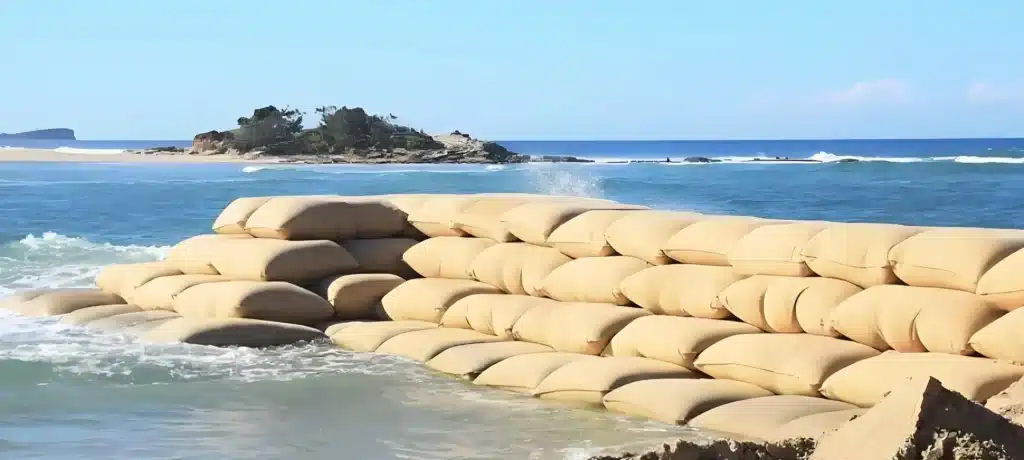
Strengths
Speed is the main win. Crews can place hundreds of small bags in a shift. The fabric filters while it confines, so you often avoid a separate filter layer. Geometry is forgiving; curves and corners are simple. Logistics are light because empty bags compress well. For coastal geobags, the big advantage is sourcing; you use onsite sand instead of importing quarry rock.
Limitations
Exposed bags degrade under UV and impact. Plan cover (soil, rock, shotcrete, or vegetation) where service is long. Small units have limited mass and can be displaced by strong flows unless stacked and keyed. Poor fill (too fine or too wet) can slump and reduce stability. Seams and stitching quality matter; cheap thread or short seam margins can fail under handling or wave action.
Practical mitigations
| Risk | Cause | Mitigation |
|---|---|---|
| UV cracking | Long exposure | UV-stable fabric, prompt cover |
| Bag displacement | High velocity | Interlock courses, use larger units or rock cap |
| Piping | AOS too open | Select AOS to soil gradation, add underlayer |
| Seam tear | Weak stitching | Double seams, QA seam peel/tear tests |
How to use geotextile sand bags?
On site, simple steps prevent most failures. A short checklist keeps crews aligned.
Prepare the base, choose proper fill, fill to the right level, close and place, then interlock courses with offsets and keys. Tie into ends and returns so flows cannot sneak behind.
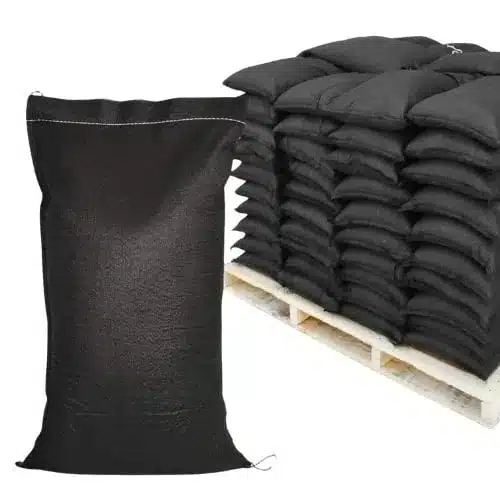
Field sequence
1) Site prep: Grade a shallow key trench where the first row sits. Remove sharp debris. Lay a nonwoven geotextile underlayer if subgrade is soft or silty.
2) Fill: Use clean, well-graded sand. Target about two-thirds fill so the bag can mold and interlock. Overfilling makes placement hard and weakens stack stability.
3) Closure: Tie with drawstring, fold flap, or stitch/zip ties as specified. Keep closures consistent to avoid snag points.
4) Placement: Start from the lowest point and build up. Stagger joints like brickwork. Tamp lightly to seat each bag.
5) Anchoring and tie-ins: At turns, build returns to lock the line. At ends, key into higher ground or existing structures. On slopes, use occasional deadman rows perpendicular to the flow.
Quality points and tolerances
| Step | Good practice | Common mistake |
|---|---|---|
| Fill level | 60–70% of nominal volume | 100% full and rounded |
| Overlap/offset | Half-bag offset per course | Vertical seams aligned |
| Base key | 10–20 cm below grade | Sitting on loose topsoil |
| Cover | Soil/rock within 24–48 h if long-term | Leaving exposed for months |
Integration
Bags combine well with geocells on soft toes, with geogrids under access ramps, and with riprap caps for hydraulic energy. This hybrid approach keeps cost down and improves safety margins.
How to make homemade sand bags?
In emergencies, you may not have factory bags on hand. A quick, safe backup helps until supply arrives.
You can make simple sand bags from sturdy woven PP sacks, old pillowcases, or heavy-duty contractor bags, then reinforce closures. These are temporary and not a substitute for engineered geobags in long-term works.
Materials and steps
Use woven PP feed sacks or thick fabric (canvas or denim). If using plastic contractor bags, double-bag them. Fill with clean sand to about half or two-thirds. Fold the top and tie with rope, zip tie, or duct tape. For extra security, add a second tie 5 cm below the first. Mark the fill date.
Where DIY works
DIY bags suit door thresholds, garage edges, and short curb runs. They buy time during a storm. They also help direct minor runoff away from entrances. For flowing streams, tall walls, or long deployments, move to factory geotextile bags with tested seams and proper AOS.
Quick comparison
| Feature | DIY bag | Factory geotextile bag |
|---|---|---|
| Strength repeatability | Low | High |
| UV stability | Low | Medium to high |
| Filtration control (AOS) | Uncontrolled | Specified |
| Best use | Short-term, small | Medium/long-term, engineered |
Safety
Lift with two people. Keep weights manageable (10–20 kg per bag) to avoid injuries. Do not use contaminated soils. Dispose of damaged DIY bags after the event.
How to choose the right geotextile sand bag?
Too many SKUs can slow decisions. A few rules make selection fast and clear.
Match fabric type to function, size to flow energy, AOS to soil gradation, and seam strength to handling method. Then lock the logistics: UV rating, packaging, and labeling for site control.
Quick selection rules
Woven PP bags suit crisp stacking and high tensile needs. Nonwoven bags suit filtration-driven tasks and contact with rough subgrades. For strong flows or waves, go larger to add mass. For fine native soils, pick a tighter AOS or add a filter underlayer.
Data to request on quotes
| Parameter | Why it matters | Typical range |
|---|---|---|
| Mass per unit area | Relates to strength and puncture | 120–600 g/m² |
| Grab tensile | Handling and stacking safety | 400–1500 N |
| Puncture/CBR | Contact with angular fill | 1–4 kN |
| AOS (O90) | Soil retention vs permeability | 0.075–0.3 mm |
| UV resistance | Exposure during service | ≥70% retained @ 500 h (guide) |
| Seam strength | Lifting/placement reliability | ≥60–80% of fabric |
Typical test set
Mass per unit area confirms the fabric class. Grab tensile and elongation show strength and ductility for handling. Puncture (CBR) and trapezoid tear indicate resistance to sharp contacts. AOS (O95/O90) and permittivity define filtration behavior. UV retention shows outdoor durability. Seam tests confirm that stitching and thread quality meet the target ratio of fabric strength.
My opinion
I usually suggest starting with the soil and the flow, not the catalog page. Choose fabric and size to control piping and movement, then plan a cover for long life. Keep the spec short, testable, and tied to risk. When crews get a one-page method with pictures, work goes fast and results hold.
FAQ
What fill is best for geotextile sand bags?
Clean, well-graded sand is the standard. Avoid high silt content that can slurry and leak or settle.
How full should I make each bag?
About 60–70% of volume. This lets the bag mold and interlock. Overfilled bags roll and split.
Can I reuse bags after a flood?
If seams and fabric are intact and not contaminated, yes. Dry them out of the sun and inspect. Replace any with tears or UV damage.
Do I need a filter layer under stacked bags?
If subgrade is fine or saturated, use a nonwoven geotextile underlayer to stop piping and punching.
How long will bags last in the sun?
With UV-stable fabric they last longer, but plan cover within weeks for permanent works. For emergency flood lines, exposure for days to a few weeks is common.
Are nonwoven bags stronger than woven?
Not always. Woven bags often have higher tensile strength. Nonwovens offer better puncture and filtration. Pick by task.
What size bag should I use near culverts?
Use larger units or double rows to add mass and resist jet velocities. Cap with rock if flows are high.
Can I pump-fill large geobags?
Yes. Coastal geobags are often pump-filled with sand slurry, then closed and shaped per template.
What thread is used for seams?
UV-stable polyester or polypropylene thread. Seam design targets a percentage of base fabric strength.
Will bags pollute water?
PP and PET are stable polymers. Use clean fill and collect damaged bags after events to avoid litter.
Can bags replace riprap?
Bags can act as a core or temporary armor. For high-energy coasts or spillways, rock or concrete armor may still be required on the face.
How do I estimate quantities?
For small bags, plan about 30–40 bags per linear meter of a 0.6 m-high wall, depending on bag size and offsets. Verify with a site mock-up.
What is AOS and why care?
Apparent opening size indicates pore size of the fabric. It controls soil retention while allowing water flow. Match AOS to native soil gradation.
Can I plant vegetation through bag structures?
Yes, especially with nonwoven fabrics and soil-filled facings. Vegetation improves long-term stability and UV cover.
How should I store empty bags?
Keep dry, out of direct sun, on pallets, and wrapped. Label bales with lot numbers for traceability.
What temperatures affect performance?
Cold makes PP stiffer during handling; avoid sharp bends. Heat accelerates UV aging; cover exposed bags sooner.
Do colored bags perform better?
Color helps visibility and blending, but UV performance depends on stabilizers, not color alone.
Are there fire concerns?
PP and PET are combustible. Keep away from open flames and sparks during storage and deployment.
How do I dispose of damaged bags?
Remove fill, recycle fabric where facilities exist, or dispose per local rules. Do not leave damaged units in waterways.
Conclusion
Geotextile sand bags give fast, flexible control over water and erosion. Match fabric and size to soil and flow, stack with care, cover for long-term work, and support decisions with simple, testable specs.

